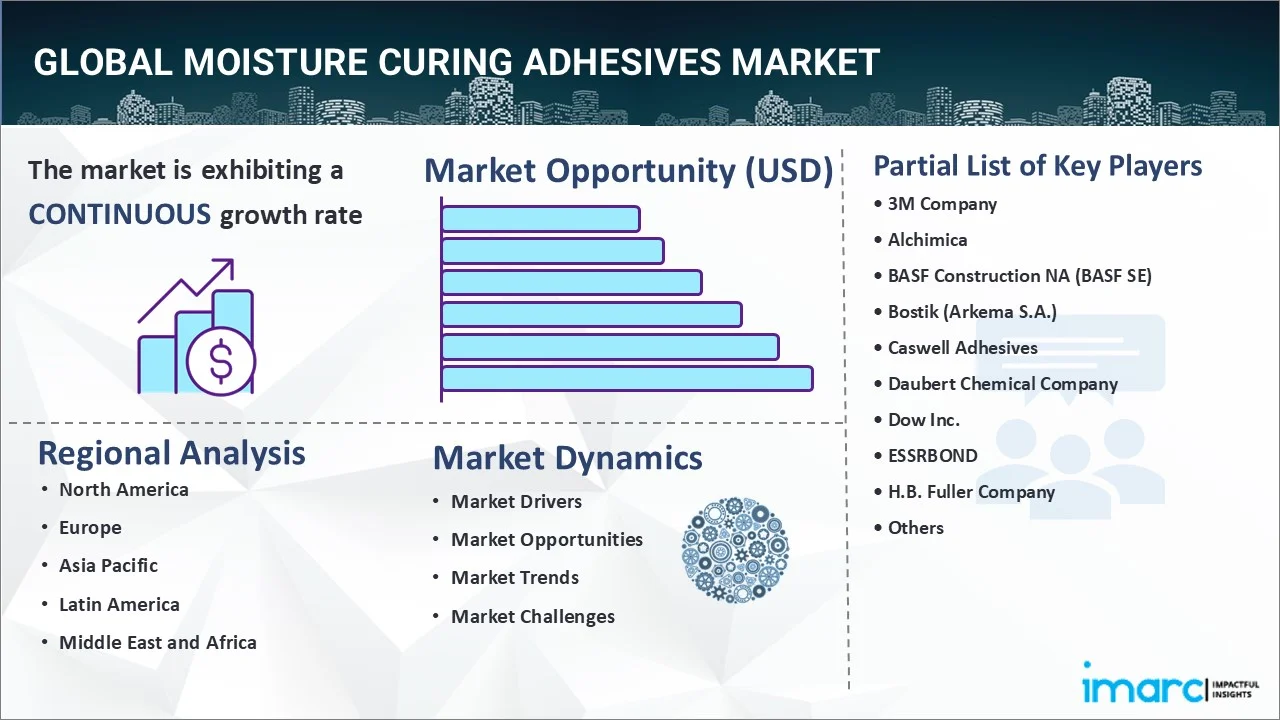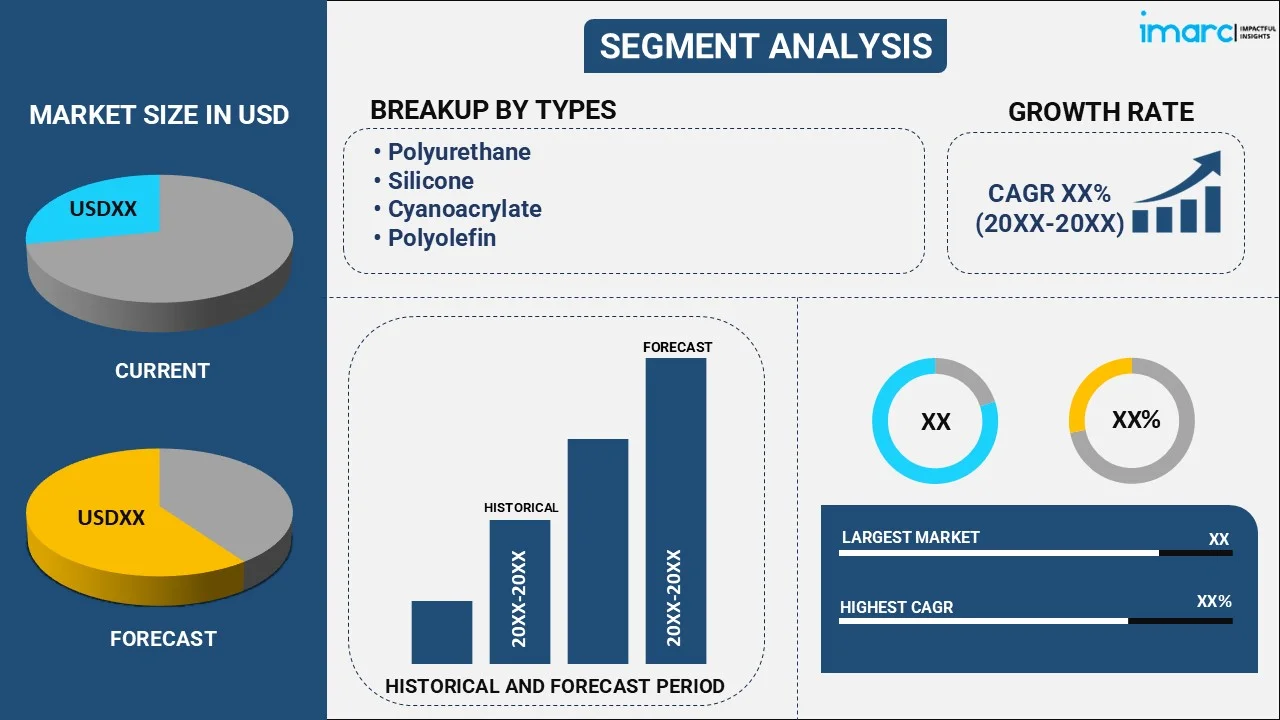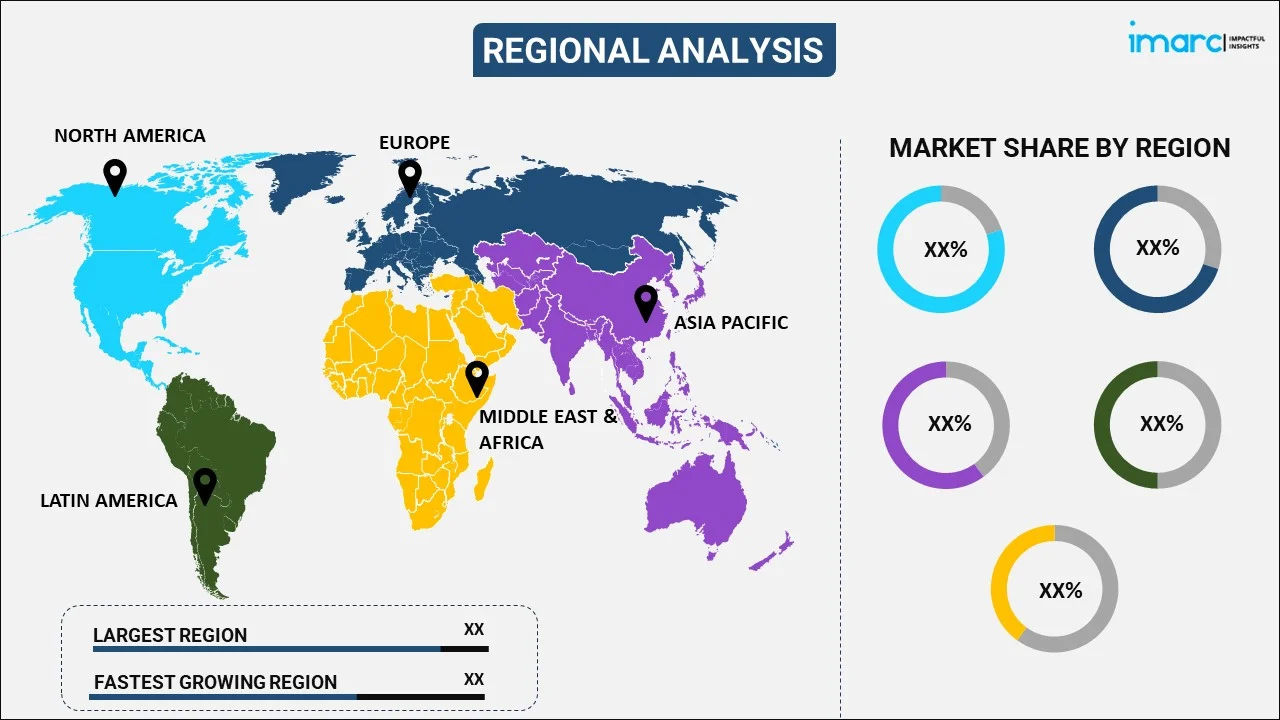
Moisture Curing Adhesives Market Report by Type (Polyurethane, Silicone, Cyanoacrylate, Polyolefin), Application (Construction, Automotive, Woodworking, Textile, and Others), and Region 2025-2033
Market Overview:
The global moisture curing adhesives market size reached USD 7.0 Billion in 2024. Looking forward, IMARC Group expects the market to reach USD 12.3 Billion by 2033, exhibiting a growth rate (CAGR) of 6.53% during 2025-2033. The increasing demand from construction and automotive industries, a growing trend towards eco-friendly products, expansion in the electronics and aerospace sectors, ongoing research and development (R&D) activities, novel applications in medical devices and renewable energy, and product customization to meet end-user requirements are some of the key factors providing a boost to the market growth.
|
Report Attribute
|
Key Statistics
|
|---|---|
|
Base Year
|
2024
|
|
Forecast Years
|
2025-2033
|
|
Historical Years
|
2019-2024
|
| Market Size in 2024 | USD 7.0 Billion |
| Market Forecast in 2033 | USD 12.3 Billion |
| Market Growth Rate 2025-2033 | 6.53% |
Moisture-curing adhesives are a type of adhesive that cures or hardens when exposed to moisture in the environment. They are formulated using polymers that contain moisture-reactive functional groups. The curing process begins when the adhesive comes into contact with water vapor, which triggers a chemical reaction within the adhesive. Moisture-curing adhesives are commonly used in various industries due to their versatility and adhesive properties. They find extensive use in construction, particularly for bonding glass, metal, and plastic components. One of their primary advantages is their ease of application. They do not require complex mixing or curing processes, which simplifies the bonding procedure. Moreover, these adhesives offer excellent adhesion to a wide range of substrates, including both porous and non-porous materials. They also exhibit good resistance to environmental factors, such as temperature fluctuations and humidity, making them suitable for both indoor and outdoor applications.

The global moisture curing adhesives market is influenced by a multitude of drivers, such as increasing demand from the construction and automotive industries, driven by their need for strong and durable bonding solutions. Additionally, the growing trend towards sustainability and eco-friendly products has led to a surge in the adoption of moisture curing adhesives, as they often contain fewer volatile organic compounds (VOCs) compared to solvent-based alternatives, which is boosting the market growth. Moreover, the expanding electronics and aerospace sectors, with their stringent requirements for reliable adhesive solutions, is contributing significantly to the market expansion. Furthermore, the rise in disposable income levels in emerging economies has boosted construction and automotive activities, further propelling the market growth. The market also benefits from ongoing research and development (R&D) efforts to enhance product performance and versatility, ensuring that these adhesives meet evolving industry needs.
Moisture Curing Adhesives Market Trends/Drivers:
Increasing demand from construction and automotive industries
The first significant driver propelling the global moisture curing adhesives market is the increasing demand emanating from the construction and automotive industries. In the construction sector, these adhesives find extensive use in bonding various materials, ranging from metals to concrete and wood. The construction industry's need for reliable and robust bonding solutions to ensure structural integrity and durability has led to a growing reliance on moisture curing adhesives. Moreover, the automotive sector has witnessed a surge in the utilization of moisture curing adhesives. These adhesives play a crucial role in manufacturing processes, such as bonding vehicle components, glass installation, and interior assembly. As automakers prioritize lightweight materials and fuel efficiency, moisture curing adhesives, known for their ability to bond dissimilar substrates efficiently, have become indispensable. Furthermore, these adhesives contribute to vehicle safety by enhancing structural integrity and crash performance.
Growing trend towards sustainability and eco-friendly products
A pivotal driver influencing the global moisture curing adhesives market is the growing trend towards sustainability and eco-friendly products. As environmental consciousness becomes increasingly important, industries across the board are seeking adhesive solutions that minimize their ecological footprint. Moisture curing adhesives have gained traction in this context due to their inherently lower levels of volatile organic compounds (VOCs) compared to traditional solvent-based adhesives. Consequently, the reduced VOC emissions associated with moisture curing adhesives align with sustainability goals and environmental regulations. Moreover, these adhesives often do not require the addition of solvents or other harmful chemicals, making them more environmentally friendly.
Expanding electronics and aerospace sectors
The expansion of the electronics and aerospace sectors stands out as another key driver of the global moisture curing adhesives market. Both industries demand adhesive solutions that exhibit exceptional reliability, performance, and durability, making moisture curing adhesives an ideal choice. In the electronics sector, these adhesives are crucial for various applications, including component assembly, circuit board bonding, and encapsulation. As electronic devices become smaller and more complex, the need for adhesives that provide excellent electrical insulation and protection against moisture and environmental factors has grown. Moisture curing adhesives offer these benefits, contributing to their widespread adoption. Similarly, the aerospace industry relies heavily on moisture curing adhesives for aircraft assembly, composite bonding, and structural repairs. These adhesives possess the necessary properties to withstand the extreme conditions encountered in aerospace applications, such as high temperatures, vibrations, and exposure to harsh chemicals.
Moisture Curing Adhesives Industry Segmentation:
IMARC Group provides an analysis of the key trends in each segment of the market, along with forecasts at the global, regional, and country levels for 2025-2033. Our report has categorized the market based on type and application.
Breakup by Type:

- Polyurethane
- Silicone
- Cyanoacrylate
- Polyolefin
Polyurethane represents the leading market segment
The report has provided a detailed breakup and analysis of the market based on the type. This includes polyurethane, silicone, cyanoacrylate, and polyolefin. According to the report, polyurethane represented the largest segment.
The polyurethane segment in the global moisture curing adhesives market is experiencing robust growth, driven by the exceptional versatility and adhesion properties of polyurethane-based adhesives, which make them highly sought after in various industries. Their ability to bond dissimilar substrates, including metals, plastics, and composites, addresses the diverse needs of applications in construction, automotive, electronics, and more. Additionally, the increasing demand for eco-friendly and low-VOC adhesive solutions aligns with polyurethane adhesives' reduced environmental impact, making them a preferred choice for sustainability-conscious industries. The superior durability and resistance to moisture, chemicals, and temperature variations further drive their adoption, particularly in challenging environments such as aerospace and marine applications. Moreover, ongoing advancements in polyurethane adhesive formulations continue to enhance their performance and broaden their application possibilities, solidifying their position as a dominant force in the moisture curing adhesives market.
Breakup by Application:
- Construction
- Automotive
- Woodworking
- Textile
- Others
Construction accounts for the majority of the market share
A detailed breakup and analysis of the market based on the application has also been provided in the report. This includes construction, automotive, woodworking, textile, and others. According to the report, construction represented the largest segment.
The construction segment is significantly driven by key factors that highlight the pivotal role of moisture curing adhesives in this industry, such as the escalating demand for robust and durable bonding solutions in projects, which has fueled the product adoption as they provide high-strength bonds essential for structural integrity. Additionally, their ability to withstand adverse environmental conditions and varying temperatures makes them ideal for outdoor applications, such as building exteriors and roofing systems. Moreover, moisture curing adhesives contribute to the construction sector's sustainability efforts, as they often contain fewer volatile organic compounds (VOCs) compared to solvent-based adhesives, aligning with green building practices and environmental regulations. Furthermore, their versatility in bonding diverse materials, including metals, concrete, and wood, makes them indispensable in various construction applications, from structural assembly to flooring installation.
Breakup by Region:

- North America
- United States
- Canada
- Asia Pacific
- China
- Japan
- India
- South Korea
- Australia
- Indonesia
- Others
- Europe
- Germany
- France
- United Kingdom
- Italy
- Spain
- Others
- Latin America
- Brazil
- Mexico
- Others
- Middle East and Africa
North America leads the market, accounting for the largest moisture curing adhesive market share
The market research report has also provided a comprehensive analysis of all the major regional markets, which include North America (the United States and Canada); Europe (Germany, France, the United Kingdom, Italy, Spain, and others); Asia Pacific (China, Japan, India, South Korea, Australia, Indonesia, and others); Latin America (Brazil, Mexico, and others); and the Middle East and Africa. According to the report, North America accounted for the largest market share.
The North American moisture curing adhesives market is being driven by several key factors, such as the robust construction industry in the region, which has surged the demand for moisture curing adhesives for bonding various construction materials, ensuring structural integrity and durability. In line with this, the automotive sector's increasing adoption of these adhesives for lightweight and fuel-efficient vehicle manufacturing contributes substantially to market growth. Moreover, the region's strong emphasis on environmental sustainability fuels the demand for eco-friendly adhesive solutions, with moisture curing adhesives being preferred for their lower VOC emissions, which is fueling the market growth. Additionally, the electronics and aerospace industries in North America rely on these adhesives for their exceptional performance and reliability in electronic device assembly and aircraft applications, which is stimulating the market growth. Furthermore, ongoing research and development activities, coupled with regulatory support, ensure the market's continuous innovation and compliance with quality standards, which is propelling the market growth.
Competitive Landscape:
The competitive landscape of the global moisture curing adhesives market is influenced by dynamic and evolving dynamics. Market players, ranging from established corporations to emerging companies, compete vigorously in this space. Factors shaping competition include product innovation, manufacturing capabilities, distribution networks, and customer relationships. Market leaders often invest heavily in research and development to create adhesive solutions with superior properties, such as enhanced bonding strength, faster curing times, and greater versatility. They also focus on expanding their product portfolios to cater to a wide range of industries and applications.
Collaborations and mergers are common strategies among key players, allowing them to pool resources, share expertise, and broaden their market reach. These alliances foster innovation and create synergies that enhance competitiveness. Customization is another competitive strategy, as adhesive manufacturers work closely with end-users to tailor products to specific needs. This approach helps companies establish long-lasting relationships with clients. Additionally, the ability to navigate complex regulatory landscapes and ensure compliance with international quality standards is crucial in maintaining a competitive edge. Adhering to environmentally friendly practices and offering eco-conscious adhesive solutions also enhances market positioning.
The market research report has provided a comprehensive analysis of the competitive landscape. Detailed profiles of all major companies have also been provided. Some of the key players in the market include:
- 3M Company
- Alchimica
- BASF Construction NA (BASF SE)
- Bostik (Arkema S.A.)
- Caswell Adhesives
- Daubert Chemical Company
- Dow Inc.
- ESSRBOND
- H.B. Fuller Company
- Henkel AG & Co. KGaA
- Jowat SE
- Sika AG
- W.W. Henry Company (ARDEX Americas)
(Please note that this is only a partial list of the key players, and the complete list is provided in the report.)
Moisture Curing Adhesives Market Report Scope:
| Report Features | Details |
|---|---|
| Base Year of the Analysis | 2024 |
| Historical Period | 2019-2024 |
| Forecast Period | 2025-2033 |
| Units | Billion USD |
| Scope of the Report | Exploration of Historical and Forecast Trends, Industry Catalysts and Challenges, Segment-Wise Historical and Predictive Market Assessment:
|
| Types Covered | Polyurethane, Silicone, Cyanoacrylate, Polyolefin |
| Applications Covered | Construction, Automotive, Woodworking, Textile, Others |
| Regions Covered | Asia Pacific, Europe, North America, Latin America, Middle East and Africa |
| Countries Covered | United States, Canada, Germany, France, United Kingdom, Italy, Spain, China, Japan, India, South Korea, Australia, Indonesia, Brazil, Mexico |
| Companies Covered | 3M Company, Alchimica, BASF Construction NA (BASF SE), Bostik (Arkema S.A.), Caswell Adhesives, Daubert Chemical Company, Dow Inc., ESSRBOND, H.B. Fuller Company, Henkel AG & Co. KGaA, Jowat SE, Sika AG, and W.W. Henry Company (ARDEX Americas), etc. |
| Customization Scope | 10% Free Customization |
| Post-Sale Analyst Support | 10-12 Weeks |
| Delivery Format | PDF and Excel through Email (We can also provide the editable version of the report in PPT/Word format on special request) |
Key Questions Answered in This Report:
- How has the global moisture curing adhesives market performed so far, and how will it perform in the coming years?
- What are the drivers, restraints, and opportunities in the global moisture curing adhesives market?
- What is the impact of each driver, restraint, and opportunity on the global moisture curing adhesives market?
- What are the key regional markets?
- Which countries represent the most attractive moisture curing adhesives market?
- What is the breakup of the market based on the type?
- Which is the most attractive type in the moisture curing adhesives market?
- What is the breakup of the market based on the application?
- Which is the most attractive application in the moisture curing adhesives market?
- What is the competitive structure of the global moisture curing adhesives market?
- Who are the key players/companies in the global moisture curing adhesives market?
Key Benefits for Stakeholders:
- IMARC’s industry report offers a comprehensive quantitative analysis of various market segments, historical and current market trends, market forecasts, and dynamics of the moisture curing adhesives market from 2019-2033.
- The research report provides the latest information on the market drivers, challenges, and opportunities in the global moisture curing adhesives market.
- The study maps the leading, as well as the fastest-growing, regional markets. It further enables stakeholders to identify the key country-level markets within each region.
- Porter's five forces analysis assist stakeholders in assessing the impact of new entrants, competitive rivalry, supplier power, buyer power, and the threat of substitution. It helps stakeholders to analyze the level of competition within the moisture curing adhesives industry and its attractiveness.
- Competitive landscape allows stakeholders to understand their competitive environment and provides an insight into the current positions of key players in the market.
Need more help?
- Speak to our experienced analysts for insights on the current market scenarios.
- Include additional segments and countries to customize the report as per your requirement.
- Gain an unparalleled competitive advantage in your domain by understanding how to utilize the report and positively impacting your operations and revenue.
- For further assistance, please connect with our analysts.
 Inquire Before Buying
Inquire Before Buying
 Speak to an Analyst
Speak to an Analyst
 Request Brochure
Request Brochure
 Request Customization
Request Customization




.webp)




.webp)












